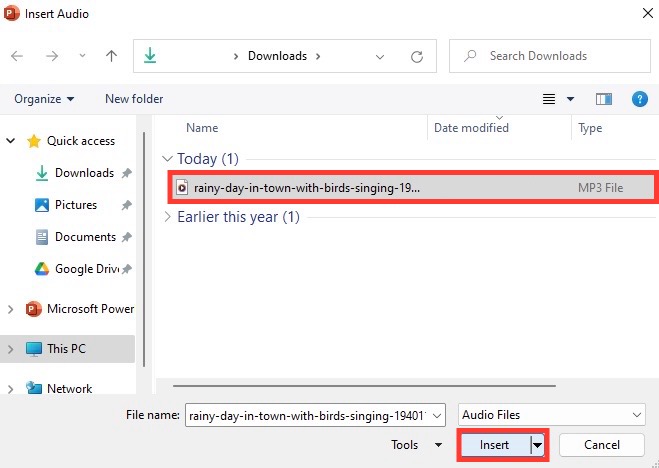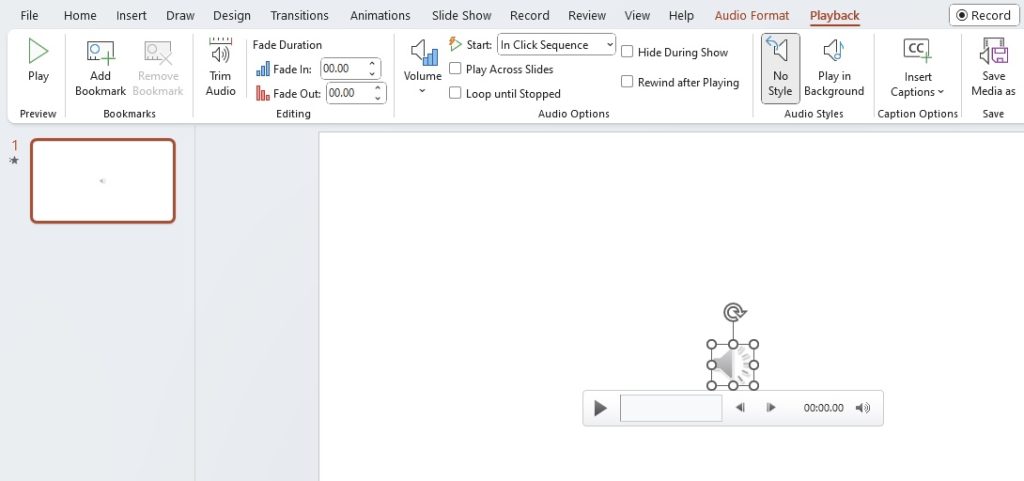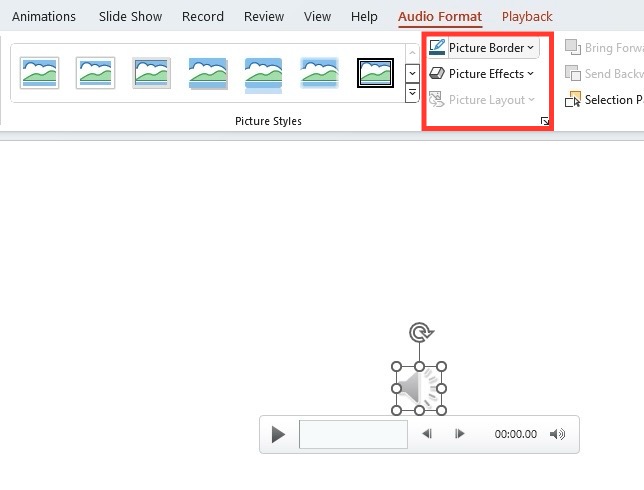Download our 141 Free Excel Templates and Spreadsheets.
Key Takeaways
- To add music to PowerPoint presentations, one method is to insert an audio file directly into the slide where you want the music to start. Users can do this by going to the “Insert” tab, selecting “Audio,” and then choosing “Audio on My PC” to pick the desired music file.
- For those looking to have music play throughout the entire slideshow, PowerPoint allows setting the audio file to play across all slides. This is achieved by going into the “Playback” tab after inserting the audio file and selecting “Play in Background,” which ensures the music continues across slides transitions.
- Simplified also offers tools to enhance presentations, including an AI-powered presentation maker that can assist in both the creation of slides and the addition of music. This can be an alternative way to design presentations and integrate music seamlessly, catering to users of varying expertise in presentation software.
Essentials for Adding Music to PowerPoint Presentations
Before you dive into the world of melodies and slides, there are a few essentials you need to master. First, understanding the format of your audio files is key for compatibility. Additionally, you’ll want to source your music legally to avoid any copyright hitches. Lastly, ensure you have the right tools—one of the most important being the latest version of PowerPoint, so you can access all the audio features seamlessly.
Table of Contents
Preparing Your PowerPoint for Audio Integration
Optimizing File Formats and Compatibility
Optimizing your audio files for PowerPoint isn’t just good practice; it’s essential for ensuring smooth playback during your presentation. You want to use file formats that are universally compatible and offer good quality without taking up too much space. MP3 and WAV formats hit the sweet spot, providing both quality and compatibility. Make sure your audio file is no larger than 16MB, which is the maximum size allowed in PowerPoint for the web. Converting your files to these formats is easy with free online tools – just ensure you’re picking a reliable one to maintain audio quality.
Step-by-Step Guide to Adding Music
Inserting Audio Files to Your PowerPoint Slides
Inserting audio files into your PowerPoint slides is a straightforward process but one that bears significant impact. Once you’ve settled on your ideal audio clip following the earlier steps, simply navigate to the slide where you want the music to commence. Go to the Insert tab and click Media>Audio, then choose “Audio on My PC.” This opens up your file explorer, and from there, you select your prepared audio file and click “Insert.” Your slide will now feature an audio icon indicating the embedded music file.
Customizing Audio Settings for Seamless Playback
Once your audio file sits snugly within a slide, it’s time to fine-tune for a polished listening experience. Select the audio icon and you’ll see the “Playback” tab lighting up with options. Here’s where you can customize your audio to blend in flawlessly with your presentation:
- Trim Audio: To fit the audio perfectly into your slide sequence, trim any excess from the start or end.
- Fade Duration: Gently introduce and exit your audio with fade effects.
- Volume: Set the right level so the music complements, not overwhelms, your presentation.
- Start options: Choose whether the audio plays automatically or on click.
- Play Across Slides: To maintain the mood, have your audio flow through multiple slides.
- Loop and Rewind: Keep the audio looping, or rewind after playing, depending on your presentation’s needs.
- Hide Icon: Keep it professional by hiding the audio icon during your presentation.
- Play in Background: This powerful feature combines playing across slides and looping.
Taking the time to adjust these settings will ensure your presentation’s audio is not just an add-on, but an integral, seamless part of the experience.
Advanced Techniques for a Professional Touch
Timing Your Audio Perfectly with Slide Transitions
Mastering the timing between your audio cues and slide transitions can turn a good presentation into a great one. On PowerPoint, this symphony is all about synchronization. Begin by inserting the audio then,
- Link the audio to the slide transition: Decide if the audio should start immediately as the slide transitions or after a delay.
- Customize the delay timing: If you prefer a pause before the music starts, tweak the delay settings under the Timing tab to hit the right moment.
- Use Animation Pane for precision: For meticulous alignment, use the Animation Pane to drag and sync your audio file with the slide transition.
Integrating your audio and visuals this tightly can enhance storytelling and keep your audience invested from one slide to the next.
Looping Background Music Throughout the Presentation
Creating a consistent ambiance for your presentation can be as simple as looping a single track across all slides. Here’s how to set this up in your PowerPoint presentation:
STEP 1: Select the audio icon on your slide and then choose the “Playback” tab.
STEP 2: Click on “Loop Until Stopped” to keep the audio rolling repetitively.
STEP 3: To ensure the music plays beyond the slide it’s placed on, you also need to select “Play Across Slides.”
This combination allows the looped track to be the backdrop for your entire presentation, maintaining a consistent atmosphere without manual intervention from slide to slide.
Common Issues and How to Solve Them
Troubleshooting Audio Playback Problems in PowerPoint
Even with careful preparation, you may encounter audio playback issues in your PowerPoint presentation. To address such problems, ensure that you:
- Check Audio File Compatibility: Make sure the audio file is in a PowerPoint-friendly format like MP3 or WAV.
- Update PowerPoint: Verify that you’re using the latest version to avoid compatibility issues with newer audio files.
- Test on Different Devices: Sometimes, an audio file might play well on one device and not another; pre-test to avoid surprises.
Familiarizing yourself with these strategies can save the day, ensuring that your audience enjoys the full impact of your well-prepared presentation.
Ensuring Audio Consistency Across Different Devices
When presenting on various devices, consistency is vital for maintaining the quality of your audio experience. Here’s what you can do to ensure that your presentation’s sound quality remains constant:
- Embed Audio Files: Instead of linking, embed your audio files directly into your PowerPoint to avoid missing audio when switching devices.
- Check Device Settings: Prior to your presentation, inspect the audio settings on the device you’ll be using to ensure they’re optimal.
- Use Standard Formats: Stick with universal audio formats like MP3 to avoid playback issues on any device.
By adhering to these simple guidelines, you can offer a smooth auditory experience, irrespective of where or how your presentation is played.
Creative Uses of Audio in PowerPoint
Incorporating Narration and Voice-Overs
Narration and voice-overs can humanize your slides and guide your audience through the presentation. You might record your own voice explaining each slide or hire a voice actor for a touch of professionalism. Here’s how you add your narrative touch:
- Record Narration: On the “Slide Show” tab, select “Record Slide Show” to start recording your voice as you navigate the presentation.
- Edit and Sync: Trim and adjust the timings of each segment to ensure your voice-over is in harmony with the slide content and transitions.
Narration not only adds a personal connection but also helps in conveying complex information in a digestible manner.
Setting the Tone with Thematic Background Scores
Choosing the right thematic background score truly sets the stage for your narrative, emotionally engaging your audience from the get-go. Be it uplifting tunes for inspiring content or serene melodies for calm discussions, align your audio with the theme of your presentation.
- Define Your Theme: Determine the feel of your presentation – is it corporate, educational, or perhaps storytelling?
- Match the Music: Select a score that mirrors the mood you want to convey – energetic beats for motivational talks or soft harmonies for reflective topics.
A thematic background score enriches the sensory experience, making your message more impactful and memorable.
Final Thoughts on Mastering PowerPoint Audio Features
Best Practices for Combining Audio and Visual Elements
Balancing audio with visuals is an art form that can take your presentation to new heights. Here are some best practices:
- Synchronization: Ensure that your audio cues align with the visuals to create a cohesive narrative.
- Complementary Audio: Choose background music that enhances the visuals without stealing the spotlight.
- Consistency: Maintain a consistent audio theme throughout to avoid disorienting your audience.
- Appropriate Volume: Set the audio at a level that supports your voice or visual content, not overshadows it.
- Test Runs: Always rehearse with both audio and visuals to catch any discordance before the actual presentation.
Marrying sound with sight strategically can make your message more engaging and your presentation more professional.
Reflecting on the Role of Sound in Memorable Presentations
The final takeaway is profound – sound plays a pivotal role in making presentations memorable. It has the power to evoke emotions, reinforce messages, and keep the audience engaged. When you consider the tempo and tone of your audio, relate it to the narrative arc of your presentation. Think about how a dramatic reveal with a musical crescendo can make a statistic resonate or how a calm narrative can underscore a reflective point.
The key is integration, not just addition. Ensure the audio feels like a natural extension of your visuals and narrative. A harmonious balance leaves a lasting impression, transforming a simple presentation into an experiential journey for your audience.
Frequently Asked Questions on How to Add Background Music in PowerPoint Presentations
Where can I get free music for my PowerPoint slideshow?
You can find free music for your PowerPoint slideshow from various online sources like the YouTube Audio Library, Free Music Archive, and Bensound. These websites offer music across different genres that are free and legal to use for presentations. Make sure to check for any attribution requirements before using the tracks.
Can I customize the audio icon on my PowerPoint presentation?
Yes, you can customize the audio icon in your PowerPoint presentation. After inserting the audio file, click the audio icon on your slide, then select “Audio Format.” You can choose “Picture Border” or “Picture Effect” to change the icon’s appearance. Remember to check “Hide During Show” if the audio is set to play automatically.
What is the preferable audio file for the powerpoint?
The preferable audio file format for PowerPoint is the MP3 format, due to its wide compatibility and balance between quality and file size, ensuring smoother playback and easier integration within your presentations.
How do you add Spotify songs to PowerPoint?
Adding Spotify songs directly to PowerPoint is not supported due to digital rights management (DRM). However, you can play Spotify music separately while presenting or use only the tracks that have been released for download and distribution by the artist. Always ensure you have proper permission to use any music in your presentation.
How do I download music for a PowerPoint?
To download music for a PowerPoint, visit royalty-free music sites like the YouTube Audio Library or Free Music Archive. Choose the track that fits your presentation, check the licensing to make sure it’s free for use, and download it to your computer. Import the downloaded audio file into your PowerPoint through the “Insert” tab.
John Michaloudis is a former accountant and finance analyst at General Electric, a Microsoft MVP since 2020, an Amazon #1 bestselling author of 4 Microsoft Excel books and teacher of Microsoft Excel & Office over at his flagship MyExcelOnline Academy Online Course.












